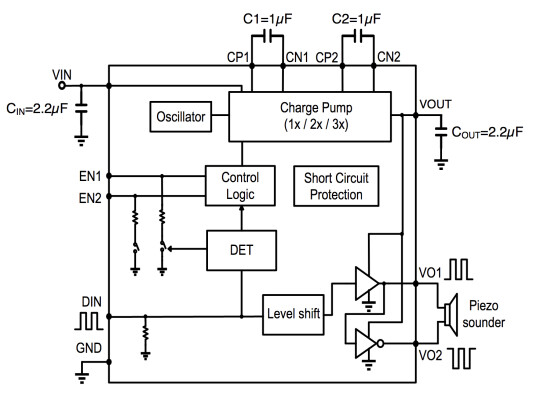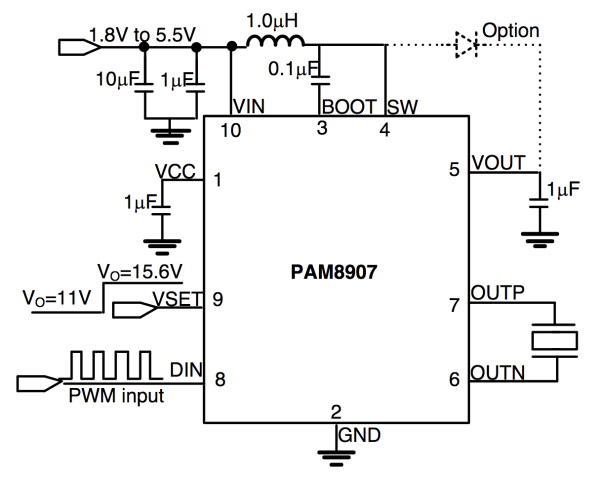How Piezo Sounder Drivers Increase Sound Pressure Levels Across a Wider Battery Voltage Range
By Leo Zhang, Audio Marketing Manager
Introduction
Piezo sounders create warning or alert noises in many applications, oftentimes in portable, battery-powered, and space-saving products. These devices consist of a ceramic element attached to a metal plate, where the ceramic element uses the piezoelectric effect to distort its shape when a voltage is applied. As it contracts and expands due to the varying voltage, the attached plate vibrates audibly.
Piezo sounders drive relatively simply by providing a different sound at different pulse-width modulation (PWM) frequencies, enabling easy modification based on application.
This article discusses the requirements for a circuit to provide the necessary driving voltage, and how an inductor-based boost converter provides higher voltage outputs (and hence louder sounds) at a wider battery voltage range than a charge pump-based approach.
Driving Piezo Sounders
There are several aspects to be considered when designing with piezo sounders, including power usage, sound output, package size, and bill-of-materials (BOM) cost.
When we talk about sound output or volume, we use the term sound pressure level (SPL), which is defined as the variation in air pressure caused by a sound. In simple terms, we can think of it as a measure of how loud a sound is. For a buzzer or alert application, it is often desirable for the SPL to be as high as possible, which means maximizing the output voltage driving the piezo sounder.
One traditional approach is to use a charge pump boost converter, as shown in Figure 1. In this example, the PAM8904E from Diodes Incorporated produces a 27V peak-to-peak (VPP) sounder output from a 4.5V supply, which comes from a 13.5V charge pump output.
The PAM8904E has a flexible design that can take an input voltage of anywhere between 1.5V to 5.5V to provide a charge pumped output in 1x, 2x, or 3x mode. With automatic shutdown/wake-up control and a very low shutdown current (less than 1µA), this combination of piezo sounder driver and charge pump goes well with a variety of applications such as security alarms, GPS locators, Bluetooth® trackers, and portable medical equipment.

Figure 1: Piezo sounder driver (PAM8904E) with charge pump
With the charge pump solution, one issue is that the output voltage is directly related to the input voltage. When the battery voltage discharges and drops gradually, the output reduces, and thus the SPL decreases. This is not desirable for many applications, and a stable SPL better ensures that design requirements are always met.
The Inductor-Based Boost Converter Solution
An alternative approach to a charge pump is to use an inductor-based boost converter to drive piezo sounders. For example, Figure 2 shows a typical circuit using the PAM8907 driver from Diodes, which includes an integrated inductor-based synchronous boost converter.
To increase flexibility, two different boost output voltages can be selected by using the GPIO—11V and 15.6V in this case—to give 22VPP or 31VPP across the piezo sounder. Having two voltage options provides two different levels of SPL available, which is useful for applications where multiple levels of sound volumes are beneficial. For example, a tracker device might start off with a relatively quiet alarm sound and then move to a louder alert if the user does not respond. This allows a system designer to select the lower 11V output to reduce power consumption, and hence extend battery life.
To accompany the boost converter, only a 1.0µH external inductor with 1A DC current rating is required. This helps keep the bill-of-materials cost low and minimize required board space. Further decreasing size, the driver itself is housed in a compact 10-pin U-QFN2020 (2mm x 2mm) package.

Figure 2: PAM8907 (with inductive boost driver) typical applications circuit
In terms of conversion efficiency, the PAM8907 will typically attain around 80% efficiency when an IL of 10mA is applied. Considering its high boost ratio and low output current, this is highly respectable and can be significant for portable, battery-powered applications.
To maximize battery life, the PAM8907 driver has automatic shutdown and wake-up functions, with a shutdown current of less than 1µA. These functions operate automatically with PWM input signal to simplify system design.
An Example Application
Let’s look briefly at a typical example application for this kind of piezo sounder: a portable Bluetooth tracker. When the tracker moves too far away from its owner’s smartphone, it emits a loud alert sound—so you hopefully never lose your keys/pets again.
![]()
Figure 3: Typical tracker applications
For the tracker, a long battery life is essential to meet consumers’ expectations. The driver’s low current consumption and automatic shutdown mode minimize power consumption, extending the battery’s lifespan. In addition, operating time can be prolonged by keeping SPL constant as the battery’s voltage drops through its discharge cycle.
Typically, this kind of application uses a CR2032 or a Li-ion battery within the PAM8907’s input voltage range of 1.8V to 5.5V. This wide range also means that the driver is capable to run off many different combinations of popular cells.
The tracker must also make a sound loud enough to hear, which a charge pump driver struggles with but a boost converter achieves with ease. Having two different output voltages (and SPL levels) allows the user to alter the sound based on external factors, such as making the alarm louder if the owner’s smartphone moves more than a certain distance from the tracker device.
Conclusion
An inductor-based boost converter approach to driving piezo sounders provides key advantages over a charge pump solution—such as the provision of a constant and stable SPL as the battery discharges. Another benefit to this approach is the flexibility to easily select from two different output voltages, as provided by the PAM8907, which enables the volume of the sound to be changed for different applications or conditions.
Bluetooth® is a registered trademark owned by Bluetooth SIG, Inc.